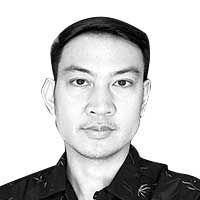Abdulmari Imao’s soaring vision & sarimanok rainbow

National Artist from the Muslim South articulated and redefined the various symbols of his heritage, transforming them into the native components of his iconography replete with folkloric, mythic and archetypal resonances.
When Toym de Leon Imao took to the stage of the Cultural Center of the Philippines for the necrological service of his father, the late National Artist Abdulmari Asia Imao, last Dec. 22, he spoke of how his daughter looked quizzical amid the hubbub of sympathizers condoling with them. “My children, and perhaps my nephews and niece, didn’t really think that their lolo was someone that important,” he said. “Maybe because their lolo never acted (as though) he was someone important in the first place.”
“Important” may not be adequate to account for the artistic contribution and legacy that Imao left after passing away last Dec. 16 at the age of 78. The first —and only — National Artist from the Muslim South, Imao in his lifetime produced an astonishing body of work in diverse media (painting, sculpture, ceramics and photography, among others) that articulated and redefined the various symbols of his heritage, transforming them into the native components of his iconography replete with folkloric, mythic and archetypal resonances.
The most famous of these symbols is, of course, his beloved sarimanok which is usually depicted with a fish dangling from its beak and whose wings, it is said, is dipped in rainbow. What could have been simply ornament became, through Imao’s modern executions, a viable artistic theme and a symbol of a people’s belief and aspiration. The CCP Main Theater, during the ceremony, was draped with hundreds of these multi-colored mythical birds, as if ready to accompany to the afterlife the master who made them.
Aside from the sarimanok, Imao exuberantly rendered, usually in acrylic on canvas or in wood and brass (his favored material), the naga (serpent) and the ukil (the flowing, curvilinear form used as decorative motif in the South). While his worldview was already decidedly cosmopolitan after studying in the United States as a Fulbright scholar and touring Europe in the early ‘60s, he never betrayed his origins and looked for thematic solutions in translating these indigenous forms into contemporary imagery.
“Deeply anchored in his tradition, Imao is an exemplar Filipino artist and should be an inspiration to all creative Filipinos, particularly those engaged in cultural work,” said the National Artist for Literature and Philippine STAR columnist F. Sionil Jose during the ceremony. “Because of his deep roots, he was able to give our art a very much distinct and very much needed Filipino face.”
Aside from embodying the Filipino identity, Julkipi Wadi, dean of the UP Institute of Islamic Studies offered that they also “crystallize the universal principles of life and the inherent unity of creation and the eternal quest, the bravery of man and woman to struggle and to reach the Highest Truth.” His works, added Sen. Grace Poe-Llamanzares (a family friend of the Imaos), don’t reflect only reality and strife but also “the dreams, the aspiration of his people. His work is a tool of unification, a tool of progress, a tool of brotherhood.”
While it is “haram” (forbidden) in Islam to depict figures as a precaution from creating false idols, Imao continued with the belief he was brought here to translate God’s grace. “Allah gave me this wonderful talent as well as skilled hands and an independent mind to create beautiful things,” said Toym, quoting his father. “Everything that comes from Allah is good and I think it would disappoint Allah if I didn’t use my God-given talent at all.”
Born in Siasi Island in Jan. 14, 1936, but spending most of his growing-up years in Pata, Jolo (two islands that dot the Sulu archipelago), the young Abdulmari was already immersed in what would eventually become his enduring subjects: the organic richness of his surroundings, the colorful patterns and ornaments of Mindanao. His childhood marked with poverty, Imao’s initial foray into art involved sketching figures on banana leaves using bamboo soot.
He would have embarked on the same trade of boat-making as his father and uncles if not for the ship transformed into a floating exhibition of Philippine masters docking on the island. Looking at their works, he got a glimpse of an alternative to the life he knew. The curator Tomas Bernardo, impressed by the young man’s drawings, convinced Imao to sail to Manila and apply for a government scholarship. And off he went to his destiny, the auspicious sarimanok perched on his shoulder.


















